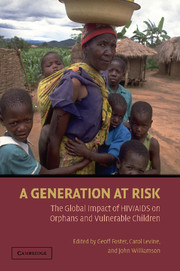Book contents
- Frontmatter
- Contents
- Foreword
- Preface
- Contributors
- Introduction: HIV/AIDS and Its Long-Term Impact on Children
- 1 Family and Community-Based Care for Children Affected by HIV/AIDS: Strengthening the Front Line Response
- 2 Strengthening Households and Communities: The Key to Reducing the Economic Impacts of HIV/AIDS on Children and Families
- 3 The Response of the Educational System to the Needs of Orphans and Children Affected by HIV/AIDS
- 4 Psychosocial Impact of the HIV/AIDS Epidemic on Children and Youth
- 5 Human Rights and Children Affected by HIV/AIDS
- 6 Religion and Responses to Orphans in Africa
- 7 Making the Right Choices in the Asia-Pacific Region: Protecting Children and Young People from HIV and Its Impacts
- 8 Troubled Tapestries: Children, Families, and the HIV/AIDS Epidemic in the United States
- 9 Interventions to Support Children Affected by HIV/AIDS: Priority Areas for Future Research
- 10 Finding a Way Forward: Reducing the Impacts of HIV/AIDS on Vulnerable Children and Families
- Chronology of Important Events
- Resource Guide
- Index
- References
1 - Family and Community-Based Care for Children Affected by HIV/AIDS: Strengthening the Front Line Response
Published online by Cambridge University Press: 05 June 2012
- Frontmatter
- Contents
- Foreword
- Preface
- Contributors
- Introduction: HIV/AIDS and Its Long-Term Impact on Children
- 1 Family and Community-Based Care for Children Affected by HIV/AIDS: Strengthening the Front Line Response
- 2 Strengthening Households and Communities: The Key to Reducing the Economic Impacts of HIV/AIDS on Children and Families
- 3 The Response of the Educational System to the Needs of Orphans and Children Affected by HIV/AIDS
- 4 Psychosocial Impact of the HIV/AIDS Epidemic on Children and Youth
- 5 Human Rights and Children Affected by HIV/AIDS
- 6 Religion and Responses to Orphans in Africa
- 7 Making the Right Choices in the Asia-Pacific Region: Protecting Children and Young People from HIV and Its Impacts
- 8 Troubled Tapestries: Children, Families, and the HIV/AIDS Epidemic in the United States
- 9 Interventions to Support Children Affected by HIV/AIDS: Priority Areas for Future Research
- 10 Finding a Way Forward: Reducing the Impacts of HIV/AIDS on Vulnerable Children and Families
- Chronology of Important Events
- Resource Guide
- Index
- References
Summary
The overwhelming majority of children orphaned or affected by HIV/AIDS in sub-Saharan Africa are currently being cared for within their immediate and extended families. For most of these children, no option is as good as living with healthy parents; where this is not possible (given the realities of the HIV/AIDS epidemic), family- and community-based sources of care are the most child-centered – and the only practical – means of responding to the scale of the problem. Considerations of both child rights and child development unequivocally support family-based care, with the responsibility for it located firmly in local communities.
Achieving a strong and reliable system of family-based care, however, requires a systematic approach to strengthening family and community capacities by mobilizing communities. Mobilizing communities in turn requires the support of national and local policy. Steps also need to be taken to provide appropriate care for those children who have slipped through family and community safety nets. This care is likely to consist of various forms of fostering (by which we mean the care of children by unrelated adults, whether informally or with agency involvement) or adoption. Both approaches need to be adapted according to cultural considerations.
This chapter has three main sections. The first section critiques the practice of offering institutional forms of care as a benevolent and efficient response.
- Type
- Chapter
- Information
- A Generation at RiskThe Global Impact of HIV/AIDS on Orphans and Vulnerable Children, pp. 11 - 36Publisher: Cambridge University PressPrint publication year: 2005
References
- 16
- Cited by



